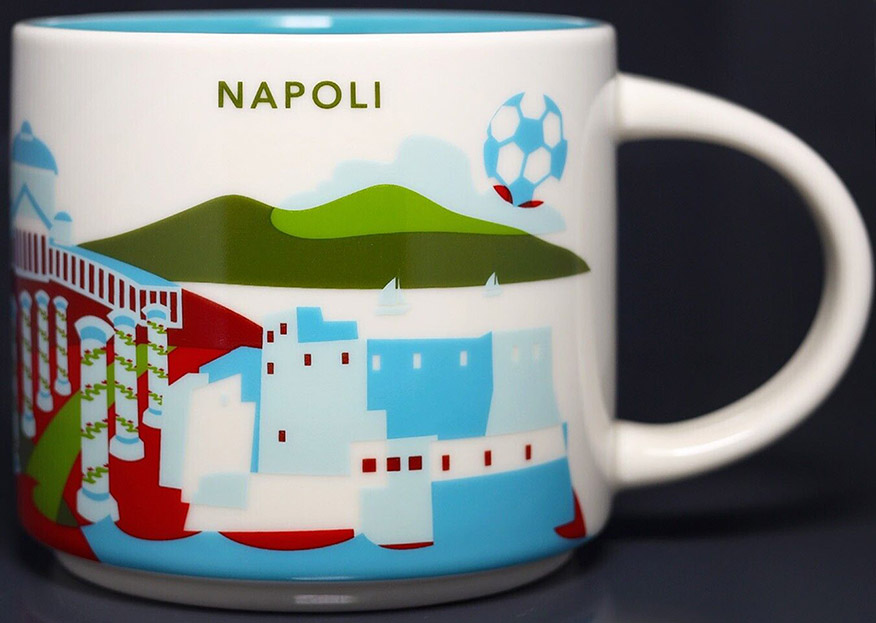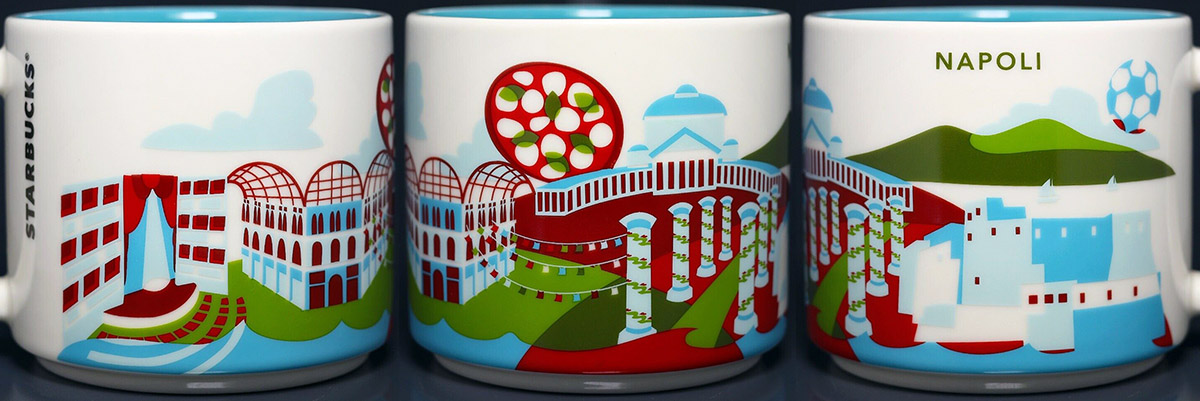
You Are Here – Napoli
Starbucks You Are Here Napoli is a mug for the city in southern Italy with a rich and diverse heritage. Founded by the Greeks in the 8th century BC as Neapolis, or “New City,” it became one of the most important cities in Magna Graecia. During the Roman era, Naples was a cultural hub, renowned for its contributions to art, philosophy, and science. The city endured a turbulent history, including periods of Byzantine, Norman, and Spanish rule, each leaving a distinct mark on its architecture and culture. In the 18th century, under the Bourbon monarchy, Naples blossomed into one of Europe’s most vibrant capitals, known for its opulent palaces and vibrant intellectual life. Today, the city’s historic center is a UNESCO World Heritage Site, reflecting its enduring legacy and cultural significance.
Here are some landmarks and the places you should visit when in Napoli:
– Mount Vesuvius, the infamous volcano that destroyed Pompeii and Herculaneum in 79 AD, remains an iconic symbol and a major attraction near Naples. Visitors can hike up to the crater of the volcano, which offers spectacular views of the Bay of Naples and the surrounding landscape. The hike provides a unique opportunity to explore the geological features of an active volcano and learn about its history and impact on the region. Visiting Mount Vesuvius is an unforgettable experience, combining natural beauty with a sense of historical significance.
– Castel dell’Ovo, meaning “Egg Castle,” is steeped in legend, with tales suggesting its name originates from a magical egg placed in its foundations by the poet Virgil. Located on the seashore, this ancient fortress provides breathtaking panoramic views of the Bay of Naples and the city itself. The castle’s strategic position has made it significant throughout history, serving various roles from a royal residence to a military fortress. Today, visitors can wander through its historic corridors, attend exhibitions, and enjoy the scenic beauty.
– The Royal Palace in Naples (Palazzo Reale), constructed in the 17th century, stands as an architectural gem and a testament to the city’s royal history. It once served as the residence of Spanish viceroys, Austrian rulers, and the Bourbon kings. Visitors can explore its opulent rooms, grand staircases, and the Royal Chapel, which are adorned with exquisite artworks and furnishings. Adjacent to the palace, Piazza del Plebiscito is an expansive and iconic square that hosts various public events and offers a stunning view of the surrounding historic buildings.
– Galleria Umberto I is a splendid 19th-century shopping arcade that showcases the grandeur of Neapolitan architecture. With its soaring glass dome and intricate ironwork, the Galleria is an architectural marvel that attracts both locals and tourists alike. Inside, visitors can find a mix of high-end shops, cafes, and restaurants, making it a perfect spot for shopping and leisure. The elegant design and vibrant atmosphere of the Galleria Umberto I make it a must-visit destination in Naples.
– The classic Neapolitan pizza features a soft, chewy crust with a slightly charred, airy edge, achieved by cooking in a wood-fired oven at high temperatures. Topped with the freshest ingredients, such as San Marzano tomatoes, buffalo mozzarella, fresh basil, and a drizzle of extra virgin olive oil, each bite offers a harmonious blend of flavors. This culinary masterpiece has earned UNESCO recognition, celebrating its cultural significance and timeless appeal.
– Soccer is immensely popular in Naples. The local team, SSC Napoli, has a huge following, and the sport is deeply ingrained in the city’s culture. The passion for soccer in Naples is palpable, with fans showing fierce loyalty and pride, especially since the legendary Diego Maradona once played for the team. The main football ground, Stadio Diego Armando Maradona (formerly Stadio San Paolo), located in the Fuorigrotta suburb, regularly hosts matches that draw large, enthusiastic crowds.
Not in the design of the mug, but still worth visiting:
– Known as the street of the nativity scene artisans, Via San Gregorio Armeno is a must-visit for those interested in traditional Neapolitan nativity scenes. The street is lined with shops selling intricately crafted figurines and other Christmas decorations.
– Spaccanapoli is a long, narrow street that cuts through the historic center of Naples. It is lined with shops, cafes, and historic buildings, offering a glimpse into the daily life of the city















































































